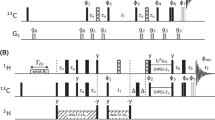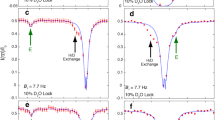Abstract
A 2D 13C Chemical Exchange Saturation Transfer (CEST) experiment is presented for studying slowly exchanging protein systems using methyl groups as probes. The utility of the method is first established through studies of protein L, a small protein, for which chemical exchange on the millisecond time-scale is not observed. Subsequently the approach is applied to a folding exchange reaction of a G48M mutant Fyn SH3 domain, for which only cross-peaks derived from the folded (‘ground’) state are present in spectra. Fits of 15N and methyl 13C CEST profiles of the Fyn SH3 domain establish that the exchange reaction involves an interchange between folded and unfolded conformers, although elevated methyl 13C transverse relaxation rates for some of the residues of the unfolded (‘invisible, excited’) state indicate that it likely exchanges with a third conformation as well. In addition to the kinetics of the exchange reaction, methyl carbon chemical shifts of the excited state are also obtained from analysis of the 13C CEST data.





Similar content being viewed by others
References
Alger JR, Shulman RG (1984) NMR studies of enzymatic rates in vitro and in vivo by magnetization transfer. Q Rev Biophys 17:83–124
Baldwin AJ, Kay LE (2012) Measurement of the signs of methyl 13C chemical shift differences between interconverting ground and excited protein states by R1rho: an application to αB crystallin. J Biomol NMR 53:1–12
Cayley PJ, Albrand JP, Feeney J, Roberts GC, Piper EA, Burgen AS (1979) Nuclear magnetic resonance studies of the binding of trimethoprim to dihydrofolate reductase. Biochemistry 18:3886–3895
Fawzi NL, Ying J, Ghirlando R, Torchia DA, Clore GM (2011) Atomic-resolution dynamics on the surface of amyloid-beta protofibrils probed by solution NMR. Nature 480:268–272
Forsen S, Hoffman RA (1963) Study of moderately rapid chemical exchange reactions by means of nuclear magnetic double resonance. J Chem Phys 39:2892–2901
Gilad AA, McMahon MT, Walczak P, Winnard PT Jr, Raman V, van Laarhoven HW, Skoglund CM, Bulte JW, van Zijl PC (2007) Artificial reporter gene providing MRI contrast based on proton exchange. Nat Biotechnol 25:217–219
Goto NK, Gardner KH, Mueller GA, Willis RC, Kay LE (1999) A robust and cost-effective method for the production of Val, Leu, Ile (δ1) methyl-protonated 15N-,13C-,2H-labeled proteins. J Biomol NMR 13:369–374
Guenneugues M, Berthault P, Desvaux H (1999) A method for determining B1 field inhomogeneity. Are the biases assumed in heteronuclear relaxation experiments usually underestimated? J Magn Reson 136:118–126
Gupta RK, Redfield AG (1970) Double nuclear magnetic resonance observation of electron exchange between ferri- and ferro-cytochrome c. Science 169:1204–1206
Korzhnev DM, Kloiber K, Kanelis V, Tugarinov V, Kay LE (2004a) Probing slow dynamics in high molecular weight proteins by methyl-TROSY NMR spectroscopy: application to a 723-residue enzyme. J Am Chem Soc 126:3964–3973
Korzhnev DM, Salvatella X, Vendruscolo M, Di Nardo AA, Davidson AR, Dobson CM, Kay LE (2004b) Low-populated folding intermediates of Fyn SH3 characterized by relaxation dispersion NMR. Nature 430:586–590
Korzhnev DM, Neudecker P, Mittermaier A, Orekhov VY, Kay LE (2005) Multiple-site exchange in proteins studied with a suite of six NMR relaxation dispersion experiments: an application to the folding of a Fyn SH3 domain mutant. J Am Chem Soc 127:15602–15611
Lauzon CB, van Zijl P, Stivers JT (2011) Using the water signal to detect invisible exchanging protons in the catalytic triad of a serine protease. J Biomol NMR 50:299–314
Levitt MH (1982) Symmetrical composite pulse sequences for NMR population-inversion. 2. Compensation of resonance offset. J Magn Reson 50:95–110
Marion D, Ikura M, Tschudin R, Bax A (1989) Rapid recording of 2D NMR spectra without phase cycling. Application to the study of hydrogen exchange in proteins. J Magn Reson 85:393–399
McConnell HM (1958) Reaction rates by nuclear magnetic resonance. J Chem Phys 28:430–431
Mittermaier A, Kay LE (2001) Chi1 torsion angle dynamics in proteins from dipolar couplings. J Am Chem Soc 123:6892–6903
Mittermaier A, Korzhnev DM, Kay LE (2005) Side-chain interactions in the folding pathway of a Fyn SH3 domain mutant studied by relaxation dispersion NMR spectroscopy. Biochemistry 44:15430–15436
Shaka AJ, Keeler J, Frenkiel T, Freeman R (1983) An improved sequence for broadband decoupling: WALTZ-16. J Magn Reson 52:335–338
Sorensen OW, Eich GW, Levitt MH, Bodenhausen G, Ernst RR (1983) Product operator formalism for the description of NMR pulse experiments. Prog NMR Spectrosc 16:163–192
Vallurupalli P, Bouvignies G, Kay LE (2012) Studying ‘invisible’ excited protein states in slow exchange with a major conformation. J Am Chem Soc 134:8148–8161
Vold RR, Vold RL (1976) Transverse relaxation in heteronuclear coupled spin systems: AX, AX2, AX3. AXY J Chem Phys 64:320–332
Ward KM, Aletras AH, Balaban RS (2000) A new class of contrast agents for MRI based on proton chemical exchange dependent saturation transfer (CEST). J Magn Reson 143:79–87
Werbelow LG, Grant DM (1977) Intramolecular dipolar relaxation in multispin systems. Adv Magn Reson 9:189–299
Wishart DS, Bigam CG, Holm A, Hodges RS, Sykes BD (1995) 1H, 13C and 15N random coil NMR chemical shifts of the common amino acids. I. Investigations of nearest-neighbor effects. J Biomol NMR 5:67–81
Zhou JY, van Zijl PCM (2006) Chemical exchange saturation transfer imaging and spectroscopy. Prog Nucl Magn Reson Spectrosc 48:109–136
Acknowledgments
G.B. acknowledges the Canadian Institutes of Health Research (CHIR) for a post-doctoral fellowship. This work was supported by grants from the CIHR and the Natural Sciences and Engineering Research Council of Canada. L. E. K. holds a Canada Research Chair in Biochemistry.
Author information
Authors and Affiliations
Corresponding author
Electronic supplementary material
Below is the link to the electronic supplementary material.
Rights and permissions
About this article
Cite this article
Bouvignies, G., Kay, L.E. A 2D 13C-CEST experiment for studying slowly exchanging protein systems using methyl probes: an application to protein folding. J Biomol NMR 53, 303–310 (2012). https://doi.org/10.1007/s10858-012-9640-7
Received:
Accepted:
Published:
Issue Date:
DOI: https://doi.org/10.1007/s10858-012-9640-7




